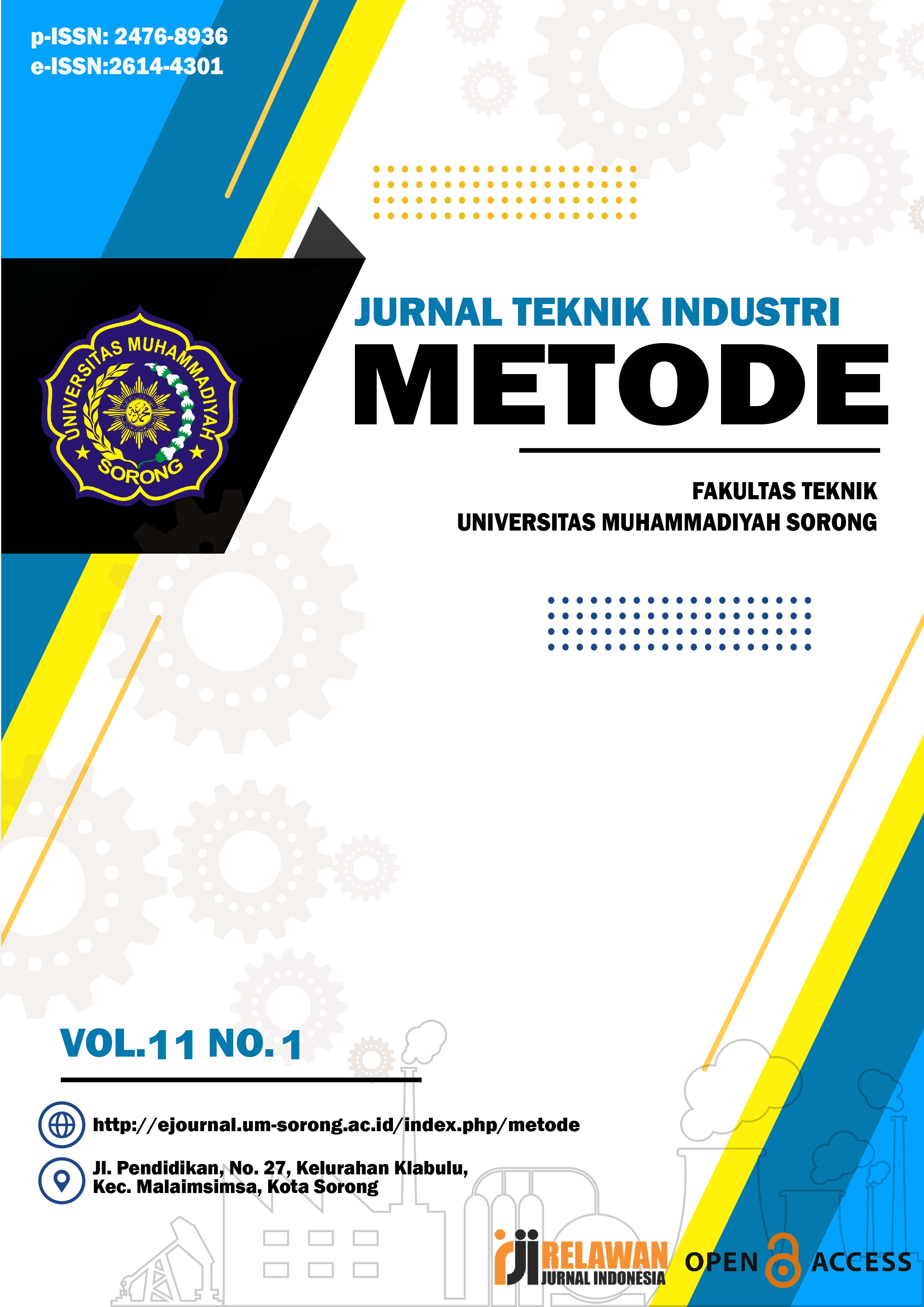Optimizing Warehouse Layout Using the Dedicated Storage Method to Minimize Goods Moving Costs
DOI:
https://doi.org/10.33506/mt.v11i1.4075Keywords:
Warehouse, Layout, Dedicated storage, Material Handling CostAbstract
The high cost of moving goods in the P3WH1 warehouse of PT Astra Honda Motor is caused by a less than optimal warehouse layout. A layout that does not have good rules will certainly make it difficult for operators to organise items to be stored or retrieved. Because it will require inefficient time and distance travelled in retrieving and storing goods. This study aims to reduce the cost of moving goods through layout improvements with the dedicated Storage method. The methods used include analysing the current warehouse layout, redesigning the layout using the dedicated storage method, and simulating the cost of moving goods before and after improvement. The results showed that the new layout can reduce the cost of moving goods and improve the operational efficiency of the warehouse. Comparison of the results of the displacement distance of the layout before and after improvement is 3,156 m / month. While the comparison of the results of the calculation of material handling costs before and after the improvement is Rp3,828,274.56/year. The main conclusion of this research is that the application of the dedicated storage method is effective in minimising the cost of moving goods. The contribution of this research is to provide practical guidance for companies in designing warehouse layouts that are more efficient and reduce operational costs.
References
Apple, J. M. (1990). Tata Letak Pabrik Dan Pemindahan Bahan. ITB Bandung.
Ashmarina, S. I., Horak, J., Vrbka, J., & Suler, P. (2021). Economic Systems in the New Era : Stable Systems in an Unstable World.
Audrey, O., Sukania, W., & Nasution, S. R. (2019). Analisis Tata Letak Gudang Dengan Menggunakan Metode Dedicate Storage. Jurnal ASIIMETRIK: Jurnal Ilmiah Rekayasa & Inovasi, 1(1), 43–49. https://doi.org/10.35814/asiimetrik.v1i1.221
Casban, C., & Nelfiyanti, N. (2020). Analisis Tata Letak Fasilitas Produksi Dengan Metode Ftc Dan Arc Untuk Mengurangi Biaya Material Handling. Jurnal PASTI, 13(3), 262. https://doi.org/10.22441/pasti.2019.v13i3.004
Casban, & Nelfiyanti. (2019). Analisis Tata Letak Fasilitas Produksi Dengan Metode FTC dan ARC untuk Mengurangi Biaya Material Handling. XIII(3), 262–274.
De Marco, A., & Mangano, G. (2011). Relationship between logistic service and maintenance costs of warehouses. Facilities, 29(9/10), 411–421. https://doi.org/10.1108/02632771111146323
Fabiani, N. A., Moengin, P., & Adisuwiryo, S. (2019). Perancangan Model Simulasi Tata Letak Gudang Bahan Baku dengan Menggunakan Metode Shared Storage pada PT . Braja Mukti Cakra. 9(2), 98–111.
Fumi, A., Scarabotti, L., & Schiraldi, M. M. (2013). The Effect of Slot-Code Optimization in Warehouse Order Picking Regular Paper. 5. https://doi.org/10.5772/56803
Hadiguna, R. A., & Heri Setiawan. (2008). Tata Letak Pabrik. ANDI Yogyakarta.
Imansuri, F., Febriyanto, R. D., Pratama, I. R., Sumasto, F., & Aisyah, S. (2023). Perancangan Tata Letak Gudang dengan Membandingkan Metode Dedicated Storage dan Class Based Storage ( Studi Kasus : Perusahaan Komponen Otomotif ). VIII(4).
Irwansyah, D., Erliana, C. I., Fahrudin, F. F., & Alfian, M. (2022). Measurement of Warehouse Layout at Rice Refinery Using Shared Storage Method. 2(4), 30–38.
Kelvin, Eliyah, P., & Rahayu, S. (2020). Penentuan Tata Letak Gudang Sparepart Non Genuine Pada Bengkel Mobil di Surabaya dengan Metode Dedicated Storage. 2(2), 47–53.
Lubis, A. M., Pane, D. A., & Nurjanah, P. (2023). ANALISIS BALANCED SCORECARD SEBAGAI ALAT PENGUKUR KINERJA PERUSAHAAN ( Studi Kasus pada PT Toyota Astra Motor ). Trending: Jurnal Manajemen Dan Ekonomi, 1(1), 209–228.
Lumbantoruan, A. P., Sagala, J., & Butarbutar, F. (2023). E-JOURNAL TEKNIK INDUSTRI FT UNKRIS DENGAN METODE DEDIKATED STORAGE DI PT . CIPTA NISSIN INDUSTRIES. 12(1), 17–25.
Meldra, D., & Purba, H. M. (2018). Relayout Tata Letak Gudang Barang Dengan Menggunakan Metode Dedicated Storage. Jurnal Rekayasa Sistem Industri, 4(1), 32. https://doi.org/10.33884/jrsi.v4i1.813
Muslim, D., & Ilmaniati, A. (2018). Usulan Perbaikan Tata Letak Fasilitas Terhadap Optimalisasi Jarak dan Ongkos Material Handling dengan Pendekatan Systematic Layout Planning ( SLP ) di PT Transplant Indonesia. 2(1).
Novarianto, F. (2017). Usulan Perbaikan Tata Letak Gudang Distribusi. Profesiensi, 2(2), 165–175.
Pandiangan, S. (2017). Operasional Manajemen Pergudangan. Mitra Wacana Media.
Salah, B., & Alnahhal, M. (2022). Automated Stacker Cranes : A Two-Step Storage Reallocation Process for Enhanced Service Efficiency.
Sitorus, H., & Ginting, M. (2020). Perbaikan Tata Letak Gudang dengan Metode Dedicated Storage dan Class Based Storage serta Optimasi Alokasi Pekerjaan Material Handling di PT . Dua Kuda Indonesia. 5(2), 87–98.
Tata, R., Gudang, L., Jadi, P., Tulangan, B., Menggunakan, D., Storage, M. D., Permana, I. H., Industri, J. T., Teknik, F., Sultan, U., & Tirtayasa, A. (2014). Relayout tata letak gudang produk jadi baja tulangan dengan menggunakan metode dedicated storage di pt. abc.
Wignjosoebroto, S. (2003). Tata Letak Pabrik Dan Pemindahan Bahan (Edisi keti). Guna Widya.
Yusriski, R., Pardiyono, R., Studi, P., Industri, T., Jenderal, U., Yani, A., & Pendahuluan, I. (2022). PERBAIKAN TATA LETAK GUDANG PENYIMPANAN. 24(April). https://doi.org/10.23969/infomatek.v24i1.5740
Zaerpour, N., Yu, Y., & Koster, R. B. M. De. (2017). Optimal two-class-based storage in a live-cube compact storage system. 5854. https://doi.org/10.1080/24725854.2016.1273564
Zhao, L., & Xue, Y. (2013). Multi-mode Intelligent Storage and Retrieval Systems in Automated Warehoue. 5(14), 3721–3726. https://doi.org/10.19026/rjaset.5.4515
Downloads
Published
How to Cite
Issue
Section
License
Copyright (c) 2025 Fajri Indrawan Imam Fajri, Florida Butarbutar, Syarif Hadiwijaya, Muhammad Nurhasan Assidiq

This work is licensed under a Creative Commons Attribution-ShareAlike 4.0 International License.









